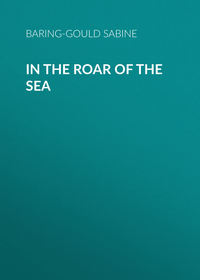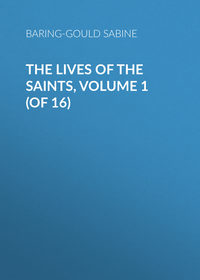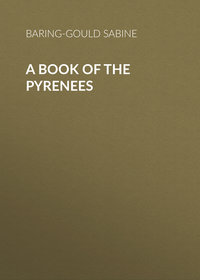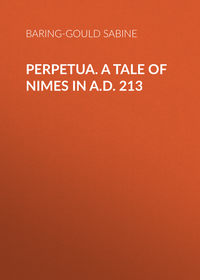 полная версия
полная версияA Book of North Wales
On the north coast is Pentraeth, at the head of Red Wharf Bay, and here may be seen the Three Leaps, by which hangs a tale.
Einion, son of Gwalchmai, was lord of Trefeilir. Now there was a young lady named Angharad, daughter of Ednyfed Fychan, who was so beautiful, and was an heiress of so much, that she had many suitors. As she professed herself unable to decide among such an embarras de richesses of nice young men, her father proposed that she should marry the youth who could jump the furthest. She agreed. When the suitors came to try their powers, Einion surpassed the rest, for with a hop, skip, and a jump he covered fifty feet. The hop, skip, and jump are marked by three stones, which remain to this day in the dingle of Plas Gwyn. So Einion became the husband of Angharad.
His happiness was of short duration, for he was summoned by Owen Gwynedd to assist in driving the Flemings out of South Wales, who had been settled there by Henry I. This was in 1137. Einion was away for a good many years, constantly engaged in fighting, and when he did return to Trefeilir he found that on that day his wife had given her hand to another suitor, supposing that Einion was dead. Einion remained without and sent a servant within to summon her to come forth, and then, striking his harp, he sang a lay of reproach that has been preserved. Then he entered the house and ejected the gentleman who had presumed to invade his premises.
The Parys Mountain rises to the height of 420 feet, and is pretty completely honeycombed with mines, as it is an almost solid lump of copper. It has been worked continually since the times of the Romans, and had probably been quarried at in the Bronze Age before that.
The little town of Amlwch is dominated by this mountain. It consists of two parts, the town proper and the port, and a considerable manufacture of chemical manures is carried on in it. Altogether Amlwch is in itself not a particularly attractive place. It has many spots of interest about it, and from it can be reached Bull Bay, where there are good sands, and the place is growing in favour. To the east the adjoining parish is Llaneilian, that possesses a quaint and interesting church, which, however, has suffered cruelly from unintelligent “restoration.” Like the majority of Welsh village churches, it has no side aisles; it is a cross church, with battlements and a western tower, covered from top to bottom in a panoply of slates. At the “restoration” the old oak seats were cast forth to make room for deal benches in preference, and the fine rood-screen with its loft had all the dainty tracery stripped from its panels and openings and destroyed, so that now it is a mere skeleton.
There is a curious little chapel at the south-east end of the church, differently orientated, and with a covered passage to it from the chancel.
This chapel has a well-preserved and good carved oak roof, which the present rector has saved from destruction by damp. Here is the base of the shrine of S. Elian. It is of wood, and the panels were formerly carved, but the tracery is gone. Into this people crawled, and if they succeeded in turning themselves about within, believed that they would get cured of any disease they might have, or, according to another version, would have their lives extended by five years.
A painting of S. Elian by an Italian artist of the seventeenth century is kept in the church, but it is devoid of merit and is in bad preservation. There is also a pair of wooden gefail gwn, or dog-tongs, bearing the date 1748.
Above Llaneilian rises the hill on which was Caswallon’s llys, or court. The story goes that Caswallon promised to Elian as much land as a stag he was hunting could run round in the day, and the deer’s spring, a leap over a rent in the rocks, is shown to this day, but it is not any longer in the parish of the saint.
A late rector of Llaneilian, John Jones, who died in 1870, and had been curate of the parish for twenty years and after that rector for thirty-three, kept his harper and also a pack of hounds.
To the west of Amlwch, in a bold situation, is Llanbadrig. The church was founded, not by the Apostle of the Irish, but by a namesake who lived later and was a member of S. Cybi’s monastery at Holyhead. According to legend, when he was on his way back from Iona, where he had visited S. Columba, his frail boat was wrecked on Ynys Badrig, or the Middle Mouse, an islet off the coast. Patrick succeeded in making his way to the land, drank of a fountain near the shore, and scrambled up the rock, in which the marks of his feet are still to be seen, to where is the church which he planted on the edge of the precipice in commemoration of his providential escape.
Within the church is a very rude cross that may well date from the time of S. Patrick. The niche at the east end of the chancel that now contains a representation of “Salvator Mundi” has twisted serpents on the pedestal, and formerly contained a figure of the patron saint, who was confounded with the Apostle of Ireland.
The parish of Llanddona is in evil repute, as a nest of witches. The story goes that a boat came ashore in Red Wharf Bay without rudder or oars, containing women and men in a condition of great destitution. They were Irish. Now it was a common custom in Ireland to punish malefactors by putting them in a wicker-work coracle, covered by a single hide, without allowing them oars or rudder. So when S. Patrick converted Maughold, the robber, he bade him drift oarless on the sea, his feet chained together. He was swept by the winds and waves to the Isle of Man, and eventually became bishop there. Now when the good people of Llanddona saw this boat come ashore thus unprovided with the necessary apparatus for its guidance, they concluded that those on board were criminals, and would have nothing to do with them. They would have sent them adrift again had not a spring of clear water burst forth on the sands where the coracle had come ashore. The spring still flows. This was decisive as a token that Heaven accepted the punishment of the crew, and desired them to rest where they had landed.
So these strangers remained, and were suffered to build cottages, but for generations they continued apart from the Welsh inhabitants, and they maintained their evil propensities. The men lived by smuggling, and the women supported themselves by the exercise of witchcraft. It was not possible to overcome the smugglers in a fray, for they carried about with them a black fly tied in a knot of their kerchief, and the moment that the knot was undone the fly flew at the eyes of their opponents and blinded them. The women, old and young, were dreaded for the power they possessed of cursing those who refused them whatsoever they asked – a fowl, a loaf of bread, eggs, part of a pig. If this were denied them, they would imprecate the most awful curses, of which here is one: —
“May he wander for agesAnd find at each step a stile,And at every stile find a fall,And at every fall a broken bone;Not the largest, nor the least bone,But the chief neck bone, each time.”If the Llanddona witches attended a market, and bid for anything, no one ventured to bid against them. But are not most Welsh girls witches? – witches, however, that win and do not revolt like those of Llanddona.
On the further side of Red Wharf Bay, where, by the way, there is an hotel, and where lodgings may be had, is Llanfair Mathafarn Eithaf. There are three parishes of the name of Llanfair in the island. Llanfair means the Llan or Church of S. Mary, the M in combination becoming f, as Llanfihangel signifies the Church of Mi[chael] the Angel.
This Llanfair Mathafarn was the birthplace of Goronwy Owen, the poet. He was born in 1722 of extremely poor parents, went to Oxford through help of Edward Wynne, of Bodewryd. Subsequently Mr. Wynne despatched him to Jesus College, Oxford, and maintained him there. From an early age he gave indications of poetic genius, and he proved himself to be a ripe scholar in the classic tongues.
He was ordained in 1745, and his great ambition was to obtain a Welsh curacy and settle down in it. Lewis Morris did his best for him, but all he could get was a temporary appointment to his native parish Llanfair, where the curacy chanced to be vacant. But he had been there only three weeks when he received notice from the Bishop of Bangor that he must turn out to make way for a young clergyman of large independent fortune; so Goronwy was obliged to depart. He sought curacies in Wales, but could get no bishop to touch him with the ends of his fingers, as he had no connections and no fortune. That he was deeply pious, earnest, a scholar, an eloquent Welsh preacher, and a poet of singular merit counted as nothing. Unhappily, though Goronwy was a genius, he was given to drink, and could never remain long anywhere. At length he obtained a curacy at Oswestry, and there he married. From Oswestry he was removed to Donnington, in Shropshire, where his rector was a Scotchman and an absentee, but being a Douglas, rich and with the means of pushing himself, having neglected his duties as parish priest, he managed to get himself nominated and consecrated Bishop of Salisbury. Lewis Morris did his best to save the poet from his unfortunate vice, but failed.
At Donnington poor Goronwy Owen not only acted as curate to the great absentee rector, but also as master of the grammar school, and received twenty-six pounds as his stipend. Thence he shifted, first into Cheshire and then to Northolt, near London. In 1756 he was living in a garret in town vainly soliciting employment in his sacred calling, and undergoing with his family the utmost privations. His Welsh accent in English stood in his way, and his brilliant Welsh qualifications were not wanted in Wales. But, indeed, poor Goronwy, with all his gifts, was not the man to do much spiritual work.
At length Lewis Morris obtained for Goronwy Owen the mastership of a Government school at Williamsburg, in Virginia. Thither he went, and there he died about the year 1770.
As Lewis Morris has been mentioned in connection with poor Goronwy Owen, a few words must be devoted to him.
“Lewis Morris,” says George Borrow, “was born at a place called Trev y Beirdd, in Anglesey, in the year 1700. Anglesey, or Mona, has given birth to many illustrious men, but few, upon the whole, entitled to more honourable mention than himself. From a humble situation in life, for he served an apprenticeship to a cooper at Holyhead, he raised himself by his industry and talents to affluence and distinction, became a landed proprietor in the county of Cardigan, and inspector of the royal domains and mines in Wales. Perhaps a man more generally accomplished never existed; he was a first-rate mechanic, an expert navigator, a great musician, both in theory and practice, and a poet of singular excellence. Of him it was said, and with truth, that he could build a ship and sail it, frame a harp and make it speak, write an ode and set it to music. Though self-taught, he was confessedly the best Welsh scholar of his age, and was well versed in those cognate dialects of the Welsh – the Cornish, Armoric, Highland Gaelic, and Irish… It was he who first told his countrymen that there was a youth in Anglesey whose genius, if properly encouraged, promised fair to rival that of Milton; one of the most eloquent letters ever written is one by him, in which he discants upon the beauties of certain poems of Goronwy Owen, the latent genius of whose boyhood he had observed, whom he had clothed, educated, and assisted up to the period when he was ordained a minister of the Church, and whom he finally rescued from a state bordering on starvation in London, procuring for him an honourable appointment in the New World.”
Lewis Morris made a collection of Welsh MSS., consisting of about eighty volumes, which are now in the British Museum. He died in 1765 and was buried at Llanbadarn Vawr, in Cardiganshire.
CHAPTER IV
HOLYHEAD
The Menai Straits to Holyhead – Llangadwaladr – The story of Cadwallon – Cadwaladr – Plague in 664 – Ruskin on Holyhead – The old caer – Chapel of the Irishman – Story of S. Cybi – The menhir of Clorach – Cybi and Elian – Church of Caergybi – Chapel of Llochwyd – Holy well – Chapel of S. Brigid – Breakwater – The South Stack – Sea-birds – Their eggs – Cytiau’r Gwyddelod – Old villages – Camp – Construction of the huts – A conservative people that votes LiberalTHE line from Bangor to Holyhead, after crossing the Menai Straits, runs through country that does not impress the traveller with an opinion that it is fertile or beautiful. The land is for the most part flat, or slightly undulating; there are no trees, much waste land, no mountains – only hills, and these away to the north. The surface of the island is speckled with little white houses with whitewashed roofs, as though a giant’s wedding had taken place there, and it was sprinkled over with the rice cast at the bride.
The line traverses the Malldraeth Marsh, and beyond Bodorgan station skirts Llyn Coron, a tarn with no picturesque surroundings, through which trickles the River Ffraw, that flows to the Aber, where once stood the residence, probably of timber, of the kings of Gwynedd.
Near the Llyn is Llangadwaladr, that takes its name from the last British prince who bore the title of King of All Britain. He was the son of Cadwallon ab Cadfan, and in the church is preserved the stone that bears the sententious inscription to inform the world that King Cadfan was “the wisest, the most renowned of all kings.”
The screen at Llaneilian has been already spoken of. It was delivered over to a joiner, who restored it by daubing over the paintings that decorated it, by hacking away the tracery that enriched it. Critics treat history in much the same fashion. They efface all the warm colouring that fancy has laid on, and eliminate all the detail which adorns it, leaving us but the naked scaffolding of fact.
If we deal in this way with the story of Cadfan and his grandson Cadwaladr, we arrive at very meagre and uninteresting outlines. We will therefore take the story much as we find it. Ethelfrid was king of Northumbria, and he sent away his wife, probably a British woman, and she took refuge with King Cadfan in Môn. There, shortly after her arrival at the court of Cadfan, the discarded queen became a mother, and bore a son to whom she gave the name of Edwin. About the same time the queen of Gwynedd bore one also, who was named Cadwallon.
The two boys were sent to be fostered in Brittany to King Solomon (there happened to be no king there of that name till two centuries later, but we will not be hypercritical).
In due course, when they were grown to man’s estate, the youths returned to Mona, and remained either there or at Deganwy till Cadfan died. Then Cadwallon assumed the crown of Gwynedd and the title of King of All Britain. Edwin went to Northumbria, where he was chosen king, and first of all the invading Angles and Saxons adopted a circlet of gold as symbol of sovereignty. Now one day Cadwallon was with his nephew Brian by the River Dulas when, overcome with the heat of the day, he laid himself down to sleep, with his head on Brian’s lap.
As he slept, Brian’s mind turned to the wrongs and sorrows that his countrymen had endured at the hands of the Teutonic invaders, and his tears ran down, and fell on Cadwallon’s face. The king was disturbed in his sleep by the falling drops, and, half asleep and half awake, he said, “It rains! It rains!”
Then he opened his eyes and saw that the sky above was blue as a corn-flower, and he remarked, “It is strange. There has been a shower, and the sun is shining. But where is the rainbow?”
Then Brian said, “Uncle, on the head of Edwin.” Cadwallon looked in his nephew’s face and saw that his eye-lashes were heavy with tears, and he asked the reason.
Thereupon Brian told him all that was in his heart, and Cadwallon rose up and vowed that he would make a desperate effort to recover the land for the British people.
So he made war on Edwin, but met with defeat after defeat, and was finally obliged to escape into Ireland.
There he resolved on seeking the assistance of the Armoricans, so he took ship and sailed for Brittany, but encountered a storm and was wrecked on an island, probably Ouessant, and all on board were lost save only Cadwallon and Brian.
Through distress at the death of his followers, and dearth of food, the king fell into a fit of profound dejection.
Brian was troubled for his uncle, whose heart seemed to be broken. He went about the island seeking for food, but could find naught. The sea-fowl had been disturbed by the gale, and the season was not that for eggs. He endeavoured to collect shell-fish, but the waters still boiled and tumbled on the rocks, and he could obtain none. Then he cut a slice from his own thigh, lighted a fire, roasted the flesh, and brought it to the king, and said that it was venison. Cadwallon, believing this, ate, and his spirit revived within him, and he determined on making an effort to reach the mainland. The wind fell, and he and Brian were able to get their battered ship afloat, and in it they were wafted over to the coast of Brittany. They went before King Solomon, who received them kindly and promised his aid.
So it was resolved that Cadwallon should return to Wales with a thousand men of Armorica, and that Brian should make his way in disguise to the court of Edwin and spy out how matters stood there.
Brian landed at Southampton, and assuming the rags of a beggar, but armed with a spiked staff, made his way to York, where was King Edwin. Brian, in a mendicant’s garb, went to the palace and stood outside among the beggars who waited daily for alms. As he thus stood his sister came forth. She had been taken captive, and had been placed in the household of the queen. She bore a pitcher, and was on her way to the well to fetch water when Brian addressed her in a whining tone. Nevertheless, she at once recognised him, and they carried on a conversation together with caution, lest he should be discovered. What he particularly desired was that a certain counsellor of Edwin should be pointed out to him by whose advice the king was principally governed, and whom the Britons regarded as a specially dangerous adversary.
Brian’s sister did so as the man issued from the door with alms for the beggars. Thereupon Brian pressed through the crowd, and, raising his staff, struck him in the breast and transfixed him there. Then he stepped back and disappeared among the beggars.
Brian now fled to Exeter, where he roused the Western Britons, and they held the city.
Meanwhile Cadwallon had arrived, and through Brian entered into a league with Penda, king of the Mercians, against Edwin. Both forces marched into Northumbria, and a battle was fought at a place called Heathfield, and Edwin was slain and his Northern Angles routed.
Then, for a while, Cadwallon reigned over all the British peoples in Wales, Strathclyde, and Devon and Cornwall.
He was succeeded by his son Cadwaladr, whose mother was a sister of Penda the Mercian. He was a good and peace-loving prince, not made of the same stuff as his father, and although he gained some victories his reign was marked by loss of ground on all sides.
He wore the crown for twelve years. In 664 a terrible plague broke out which spread desolation over Britain and Ireland, and in the latter swept away two-thirds of the inhabitants. Cadwaladr was one of the victims, and was buried in the church that bears his name by Llyn Coron. The church has an east window to the chancel of a flamboyant character, with some old stained glass in it representing the Crucifixion and saints.
The line to Holyhead passes a cluster of lakes of not much beauty – that of Llyn Penllyn has a little island in it – then it crosses a causeway into Holy Isle, and draws up at the terminus of Holyhead, under Pen Caergybi, the highest elevation in Anglesey.
Ruskin says: —
“Just on the other side of the Mersey you have your Snowdon and your Menai Straits, and that mighty granite rock beyond the moors of Anglesey, splendid in its heathery crest, and foot planted in the deep sea, once thought of as sacred – a divine promontory, looking westward, the Holy Head or Headland, still not without awe when its red light glares first through the gloom.”
The cliff scenery here is of the finest quality, and Holyhead well merits a prolonged visit, what with the stimulating air rushing through one’s lungs charged with sparkles, the look-out on the green sea flecked with foam and skimmed by gulls as flakes of froth that have been detached from the waves and become alive, the plunging water on the beach, the purple folds of the hills, and the abrupt cliffs, their feet ever bitten into and worried by the angry waves.
The town is as busy as Beaumaris is inert. It lives on the Irish trade, whereas Beaumaris picks up subsistence during a few short months only from bathers.
The one object of antiquarian interest in the town is the church, planted in the midst of an old caer, or fortress, the walls of which still stand in places 16 feet high, and are over 6 feet thick. The enclosure is quadrangular, and measures 220 feet by 130 feet. To what period the walls belong is hard to determine. They are constructed of unshaped blocks of granite rounded by the action of wind and rain, and are set in mortar made of sea-shells. In places they are arranged herring-bone fashion. The construction is too uncouth to be Roman, and the round towers at the angles are not Irish. It is certainly prior to the English conquest. A Norman builder would have disdained to put forth such work, and it is probably a unique specimen of a caer of late British erection. The two entrances are much more modern. This fortress was held by the Gwyddyl against Caswallon Long-hand. Then the walls were of stones set up without mortar, and probably faced with huge granite slabs. Caswallon forced his way in, and slew the Irish king Serigi with his own hand, where now stands Llan-y-Gwyddel in the churchyard.
The chapel had a chancel, which has been pulled down, and it was converted into a grammar school in 1748, but is now disused. After the expulsion of the Irish the enclosure became a royal caer, and was occasionally occupied by Maelgwn Gwynedd, who made it over to S. Cybi.
The story of the saint is as follows. Cybi was the son of Solomon, king of Cornwall, and Gwen, the aunt of S. David. He was born between the Lynher and Tamar at Callington, and was sent to school when aged seven. Till he was twenty-seven years old Cybi remained in Cornwall, and then he started on his travels on the Continent. There he made the acquaintance of S. Elian the Pilgrim, and a friendship was formed that was to last through life, though little did both suppose at the time that they would be neighbours in their old age. From his travels Cybi returned to Cornwall, where he became involved in a political disturbance.
His father had died whilst he was away, and his uncle Cataw, or Cado, had assumed the rule, but he was succeeded by the turbulent Constantine. The arrival in Cornwall of Cybi gave occasion to an insurrection, and an attempt was made to displace Constantine, and elevate Cybi to the throne. It failed, and Cybi was obliged to fly for his life. He took with him a party of attached disciples and his uncle Cyngar. After a brief stay in Glamorgan he crossed into Ireland, and visited S. Enda in Aran, and remained with him for four years.
Cyngar was so decrepit with age that he could eat no solid food, and Cybi bought a cow with its calf to supply the old uncle with milk. This led to ructions. The calf strayed into the meadow of a monk of the name of Fintan, who impounded it. The consequence was angry altercation and so much unpleasantness that Cybi had to leave. He crossed to Ireland, took boat in Dublin Bay, and landed in Lleyn, the rocky promontory of Carnarvon, where his wicker-work coracle got on a reef that tore the leather covering. However, all reached the shore in safety, and Cybi founded a church where is now Llangybi, near Pwllheli.
Maelgwn, king of Gwynedd, was hunting in Lleyn one day, when a goat he was following fled for refuge to Cybi’s cell, and this led to the king meeting the saint. He was so impressed with his goodness and dignity that he made him a present of the caer at Holyhead, and to this day the Welsh name for the town is Caergybi.









